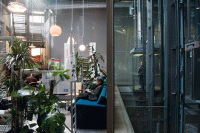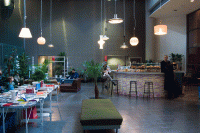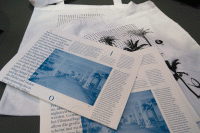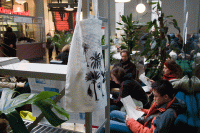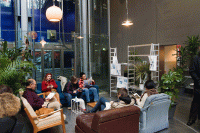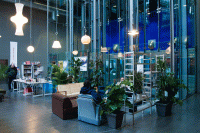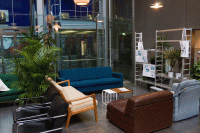lobby
Setting and Bar in the Foyer of Filmhaus
invited by Forum Expanded / Berlinale – 60. Internationale Filmfestspiele Berlin 2010
A Project of Martin Beck, Joerg Franzbecker, Heiko Karn, Katrin Mayer
.
lobby -Lektüren
....scroll down for english version and pictures....
Ausgehend von Beobachtungen in Berliner Hotels der zwanziger Jahre beschreibt Siegfried Kracauer die Hotellobby als einen paradigmatischen Ort der Moderne. Im Zuge der Expansion des Tourismus im 19. Jahrhundert wird die Lobby zum Transitraum zwischen öffentlichen und privaten Räumen, Treffpunkt und temporären, unbestimmten Aufenthaltsort.
Kracauer fasst diesen Charakter des Unbestimmten in der Beschreibung der Lobby als ‚negative Kirche‘. Gegenüber dem sakralen Versammlungsort der Gemeinschaft, oder auch den zweckgebundenen Sitzungszimmern der Konzerne, ist die Lobby vor allem ein Ort der Zerstreuung, wo die Gesellschaft in ihre atomaren und anonymen Bestandteile zerfällt. Ein Ort, an dem man ‚gleichsam im Raume an sich zu Gast‘ ist. Hierin wurzelt ein merkwürdiger Doppelcharakter der Lobby, insofern sie Lesbarkeit zugleich annulliert und in hohem Maße herausfordert. Zum einen hüllt -der Ort das wahre Geschehen immer wieder in den Schleier der Anonymität und Konvention, zum anderen versetzt er die Anwesenden in einen Zustand gesteigerter gegenseitiger Beobachtung. In einem derartigen Szenario, das Kracauer mit dem Aufführungscharakter eines Filmsets vergleicht, begegnen sich die Personen als Masken, die sich in ihrer ‚monologischen Phantasie‘ gegenseitig ‚Bezeichnungen anhängen‘. Die ‚seltsamen Geheimnisse‘, die die opaken Oberflächen ebenso verbergen wie evozieren, machen die Hotelhalle zum prädestinierten Ort des Detektivromans. Nicht zuletzt verdankt sich ihr narratives Potential der Überschneidung sozialer Sphären und einer ständigen Möglichkeit der zufälligen Begegnung.
An der Stelle des heutigen Sony Centers stand zu Kracauers Zeiten das 1907 erbaute Grand Hotel Esplanade. Indem der jetzige Bau dessen ausgebombte Reste integriert, stellt er diese als auratische Relikte des Berlin des frühen 20. Jahrhunderts aus, und evoziert dessen Mythos als Metropole der Moderne. Die Architektur des Filmhauses selbst lässt mit ihrer Glasfassade, den Glasaufzügen und dem ins Untergeschoss verlegten Foyer an eine andere einflussreich gewordene Hotelanalyse denken - Frederic Jamesons Auseinandersetzung mit John Portmans Westin Bonaventure Hotel in Los Angeles. Dessen Architektur beschreibt er als exemplarisch für einen ‚postmodernen Hyperspace‘, der sich selbst an die Stelle des urbanen Außenraums zu setzen versucht und zugleich die Fähigkeit des Individuums, sich zu lokalisieren und seine Umgebung distanziert wahrzunehmen tendenziell auflöst. Folgt man der Analyse Jamesons, so sind es spezifisch die Glasaufzüge, die einen ‚narrative stroll‘, eine freie Bewegung der Raumaneignung, wie sie der urbane Flaneur der Moderne noch erleben konnte, medialisieren und in ein reflexives Zeichen übersetzen. Man könnte sagen, dass im Filmhaus dasselbe mit der Logik des Ankommens und Auftretens geschieht. Als Apparate des ‚Sehen und Gesehen Werdens‘ ermöglichen die Aufzüge den Ankommenden einen kurzen Moment des Überblicks, exponieren sie aber zugleich als Statisten einer architektonischen wie technologischen Inszenierung, die sich an die Gäste unten im Foyer zu richten scheint.
.
.
.
lobby readings
Based on his observations of Berlin hotels in the twenties, Siegfried Kracauer describes the hotel lobby as a paradigmatic site of modernity. In the course of the expansion of tourism in the 19th century, the lobby becomes a transit space between public and private space, a meeting point and a temporary, undetermined resting spot.
Kracauer conceptualizes this undetermined character by describing the lobby as a ‘negative church.’ In contrast to the sacred gathering place of the congregation, as well as the utilitarian conference rooms of corporations, the lobby is a place of dispersion and distraction, where society falls to its atomic and anonymous pieces. A place where we are ‘guests in space as such.’ Herein lies the root of the lobby’s strange double quality, inasmuch as it cancels out legibility, while at the same time demanding it to a large degree. On the one hand the place constantly wraps real events in the veil of anonymity and convention, on the other it shifts those present into a state of increased mutual observation. In such a scenario, which Kracauer compares with the performative character of a film set, the individuals meet as masks, whose ‘monological fantasy attaches designations’ to each other. ‘Strange mysteries,’ simultaneously concealed and evoked by the opaque surfaces, render the hotel lobby a predestined site of the detective novel. Its narrative potential, not least, derives from the overlapping of social spheres and the permanent possibility of a chance encounter.
In Kracauer’s time, the location of today’s Sony Center was the site of the Grand Hotel Esplanade, built in 1907. By incorporating its bombed-out remnants, the present structure exhibits them as auratic relics of early 20th century Berlin and evokes its myth as a metropolis of modernity. The architecture of the Filmhaus itself, with its glass façade, glass elevators, and the foyer displaced into the basement, might remind us of another well-known hotel analysis–Frederic Jameson’s examination of John Portman’s Westin Bonaventure Grand Hotel in Los Angeles. Its architecture serves as an example of a ‘postmodern hyperspace,’ which attempts to substitute itself for urban outdoor space and at the same time tends to dissolve the individual’s ability to locate himself and perceive his environment with any kind of distance. Following Jameson’s analysis, it is specifically the glass elevators that refer to a ‘narrative stroll,’ a free movement of the appropriation of space still experienced by the urban flâneur of modernity, and that translate it into a reflexive sign. We might say that the same thing happens in the Filmhaus with the logic of arriving and making an appearance. As an apparatus of “seeing and being seen” the elevators provide those arriving with a short moment of overview, at the same time exposing them as players in a staging that is both architectural and technological, and which seems to be targeted at the guests below in the foyer.
.
.
.
with
lobby paper
Layout by Maren von Stockhausen
.
.
.
and
lobby Playlist:
Oliver Augst / Marcel Daemgen
*max 9.2
Compiled by Erich Pick:
Hauschka
*Chicago Morning
World Standard
*Tic Tac
Tied + Tickled Trio
*Chlebnikov
Michaela Melián
*Brautlied
Christian Naujoks
*Bar 27
Asia Today
*I luv U
Lawrence
*Until Then, Goodbye
Christian Naujoks
*Idyll
aleph-1
*C A C 08.2.2
Michaela Melián
*Convention
Lawrence
*Sunrise
Denzel + Huhn
*Paraport
aleph-1
*C A G 08.4s
Christian Naujoks
*Two Epilogues: No. 2
***
Gunter Adler
*Scheppertones
.
.
.
Fotos: Heiko Karn

